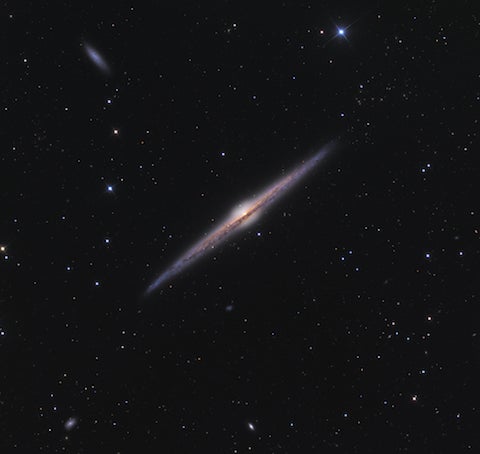Hundreds of billions of stars make up the barred spiral galaxy that we call home. The Milky Way’s 100,000 light-year diameter houses stars of different masses, luminosities, and ages, with new stars constantly being added to the mix. Star formation isn’t showing signs of slowing down, and this includes births at the outer edges of the galaxy. Could these young stars forming near the galactic edge be expanding the size of the Milky Way?
A team of researchers, led by Ph.D. candidate Cristina Martínez-Lombilla of the Instituto de Astrofísica de Canarias in Spain, presented research supporting this idea at the European Week of Astronomy and Space Science on April 3.
Older, lower-mass stars are abundant near the galaxy’s center and in the halo that looms around the Milky Way’s disk, while younger stars form within the disk itself (the spiral arms). Because some of these hotbeds for star formation lie near the disk’s edge, the researchers set out to study how these new additions could impact the Milky Way’s dimensions.
However, the issue with studying the expansion of the Milky Way is our location — a comprehensive viewpoint is difficult to obtain when you’re within the object of observation. To get a clearer perspective, the researchers studied nearby spiral galaxies with similar properties to our own. In particular, they set their sights on NGC 4565, a galaxy with a 100,000 light-year diameter estimated to be between 30 and 50 million light-years from Earth.
Martínez-Lombilla and her team used a combination of space- and ground-based telescopes to observe star activity on the outer edges of NCG 4565’s disk. The Sloan Digital Sky Survey telescope allowed them to collect optical data, while the Spitzer and GALEX space telescopes gathered near-infrared and near-UV data, enabling them to see the motions and colors of the distant stars.
They measured the light emitted from these areas to determine the types of stars present, which were mainly young blue stars, and also measured their movement within the region to determine how long it takes them to start traveling outward. Their calculations show that, based on star motions, galaxies similar to the Milky Way are expanding by about 1,640 feet (500 meters) per second.
“The Milky Way is pretty big already. But our work shows that at least the visible part of it is slowly increasing in size, as stars form on the galactic outskirts. It won’t be quick, but if you could come back and look in 3 billion years’ time the galaxy would be about 5 percent bigger than it is today,” said Martínez-Lombilla in a press release.
Looking even further down the line, the Milky Way’s borders are expected to change significantly during its anticipated collision with the Andromeda Galaxy. But that won’t likely occur for another 4 billion years, so until then, we can continue to observe galaxies similar to our own to obtain even more detailed and definitive data about the Milky Way’s immediate future.










